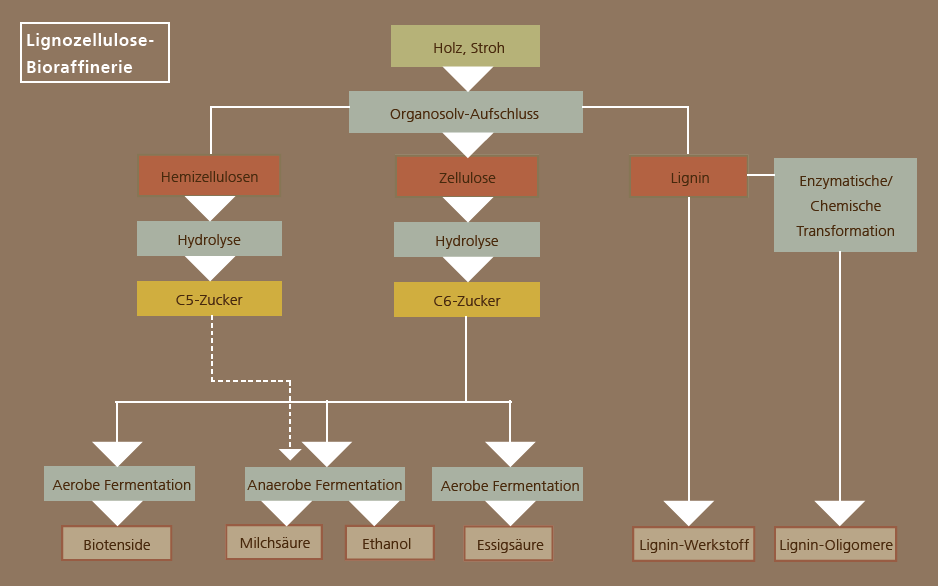Biomass represents an alternative and renewable raw material basis for the production of chemical products. If renewable raw materials or biogenic residues are used instead of fossil carbon sources for the production of chemicals, this helps to reduce greenhouse gas emissions and protect the climate.
The research field is being pursued on an interdisciplinary basis at Fraunhofer IGB in Stuttgart and the institute's branches in Straubing (BioCat) and Leuna (Fraunhofer CBP). Our work is aimed at the development of fermentative or biocatalytic processes and, if necessary, the coupling with chemical processes. Already during the development of conversion processes on laboratory scale and the optimization of biocatalysts, the scalability of the processes as well as the reprocessing of the products is in the focus of our work. At the Fraunhofer Center for Chemical-Biotechnological Processes CBP in Leuna, the institute has pilot plants that are used for realization up to production-relevant dimensions.
From raw material to product: our offer for the production of biobased chemicals
What are biobased chemicals?
Biobased chemicals are substances produced from renewable or regenerative raw materials. As a rule, these are organic raw materials that originate from agricultural and forestry production and are specifically used by humans for further applications outside the food and feed sector. Biobased chemicals and materials are already used in various markets, for example as starch products or cellulose fibers. Surfactants produced from vegetable oils and fats have also conquered applications in the cosmetics and detergent industries.
The goal of the bioeconomy is to use more biobased raw materials in the future in order to provide products for industry, the energy sector, but also for mobility. This requires detailed analyses, simulations, concepts and processes. The focus is on questions relating to crop cultivation and land requirements as well as biomass potentials, conversion technologies and biobased value creation chains within the framework of biorefinery concepts.
Our range of services at a glance
At Fraunhofer IGB we are engaged in the development of processes for the recovery of platform and fine chemicals from biogenic material flows. Questions on the efficient use of biogenic residual and waste streams are answered as well as the development of processes for the production of biobased chemicals and products. We investigate derivatized and functionalized raw products and the production of drop-in and platform chemicals as important intermediates or of fine chemicals and specialties.
With the competencies established at Fraunhofer IGB, a wide range of process steps for the development of procedures can be mapped. This combines processes for the supply and conditioning of raw materials, the isolation of material flows and chemical and biotechnological conversion. The development of chemical catalysts and tailor-made enzymes is established know-how at the IGB and can be used as a technology module for establishing suitable chemical and biotechnological processes for the conversion of renewable raw materials and biogenic residues. Processes for effective product separation and purification are also implemented.
With the pilot plants and scale-up facilities available at the IGB, developed processes can be validated and optimized for industrial implementation. We provide sample quantities in kilogram and ton scale for application-technical investigations. As a basis for further process and plant design on a demonstration or industrial scale, we carry out a techno-economic evaluation together with partners.
Raw materials and biomass fractionation
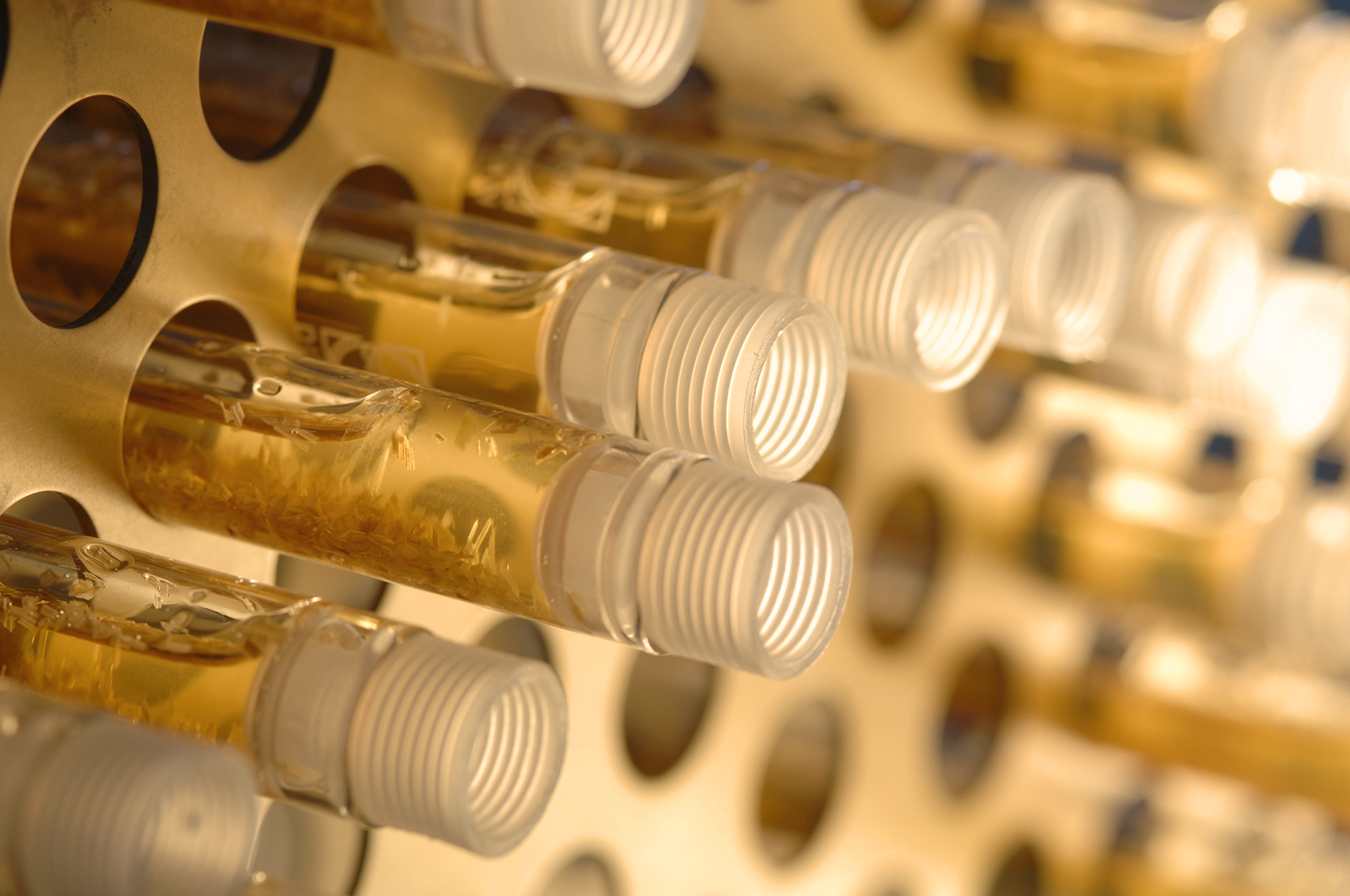
Renewable raw materials
Plants photosynthetically form a huge, so far only incompletely used spectrum of different chemical compounds. Starting materials for industrial biotechnology are primarily agricultural products such as cereals, legumes or oil plants. These biogenic raw materials are not completely constant in composition and raw material content, but vary slightly – depending on variety and cultivation conditions.
The content of special metabolites for "building blocks" or as a substrate for bioconversion depends both on the plant species and the extent of breeding work. Valuable plant substances for industrial biotechnology are mainly oils and fats as well as polysaccharides, but also polyoses and various secondary plant substances, such as phenolic acids, flavonoids, glucosinolates, isoflavones, lignans or pigments.
Various raw material sources for the production of biobased chemicals have already been intensively examined, for example lignocelluloses, carbohydrates, fats and oils as well as microalgae. Biogas, synthesis gas and CO2 also play an increasing role.
| Raw and Residual materials | Usable Fractions |
|
|---|---|---|
| Forestry-based | wood, bark | lignocellulose |
| Agricultural |
straw | oil seeds | lignocellulose | oils |
| Aquatic |
algae | crab shells | carbohydrates, proteins, lipids | chitin |
| Industrial |
CO2, waste wood, black liquor, food residues | pomace, fruit and vegetable waste, crab shells |
| Municipal | sewage sludge |
organic fraction |
| Animal | insects, crab shells, meat-and-bone meal | animal fats, extracts |
Processing
In order to make the raw material components accessible to the microorganisms or enzymes, several processing stages have to be passed through, depending on the type of starting material. These are mechanical, thermal or chemical processes which have to be adapted to the subsequent bioconversion.
Organic/biogenic residues
Residual materials, such as those generated in agriculture or food production, often still contain useful metabolites. A major focus at the IGB is on intensifying the use of residual and waste streams. With integrated bioprocesses, in which special microorganisms or biocatalysts convert individual, valuable substances in a targeted and specific way, waste disposal can be combined with the production of valuable materials. One example is sour whey, a residue from milk processing that still contains a lot of lactose. This can be converted into lactic acid by a combination of fermentation and various membrane processes such as filtration and electrodialysis and recovered as a product. Lactic acid can be used as a basic chemical in the chemical industry or further refined directly by polymerization to polylactide, a biodegradable plastic.
Another waste product that occurs in large quantities is crab shells from aquaculture or insect exuviae from the protein production of animal feed. These contain chitin, the most common biopolymer after cellulose. Fraunhofer IGB has identified microorganisms and enzymes as part of various projects with the aim of first purifying chitin as a raw material source and developing it for conversion to chitosan or chitin oligomers as well as the monomer. In addition, functional groups can be introduced to enable new properties, e.g. for a functional finishing of textiles.
Particular attention should be paid to lignocellulosic raw materials – wood or straw as residues from agriculture and forestry. These are currently still mainly used for the production of energy (combustion) or cellulose, as the compound of cellulose, hemicellulose and lignin cannot be used for biotechnological or chemical conversion without suitable pretreatment. Specially developed mechanical-chemical pulping and fractionation processes also allow lignocellulosic raw materials such as wood or straw to be used effectively as materials. In national collaborative projects such as the lignocellulose biorefinery, Fraunhofer CBP has further developed the organosolv process developed at Fraunhofer ICT and successfully implemented it on a pilot plant scale. In parallel, Fraunhofer IGB has optimized and scaled up a biotechnological approach for the enzymatic digestion of sugars from pretreated lignocellulose from wood waste or straw. In addition, new enzymes for the functionalization of lignin building blocks were characterized.
- Innovation field Regenerative Resources – Biomass fractionation
- Lignocellulose biorefinery at Fraunhofer CBP (cbp.fraunhofer.de)
- Services Biomass fractionation at Fraunhofer CBP (cbp.fraunhofer.de)
Reference projects
- ChitoTex – Development and production of new insect chitosan and chitosan based functional coatings for yarns and textile fabrics
- SteamBio – Flexible Superheated Steam Torrefaction and Grinding of Indigenous Biomass from Remote Rural Sources to Produce Stable Densified Feedstocks for Chemical and Energy Applications
- EthaNa® – Piloting the Ethanolic Native Extraction of Peeled Rapeseed (cbp.fraunhofer.de)
- UNRAVEL – UNique Refinery Approach to Valorise European Lignocellulosics (cbp.fraunhofer.de)
Conversion processes: fermentation, biocatalysis and chemical catalysis
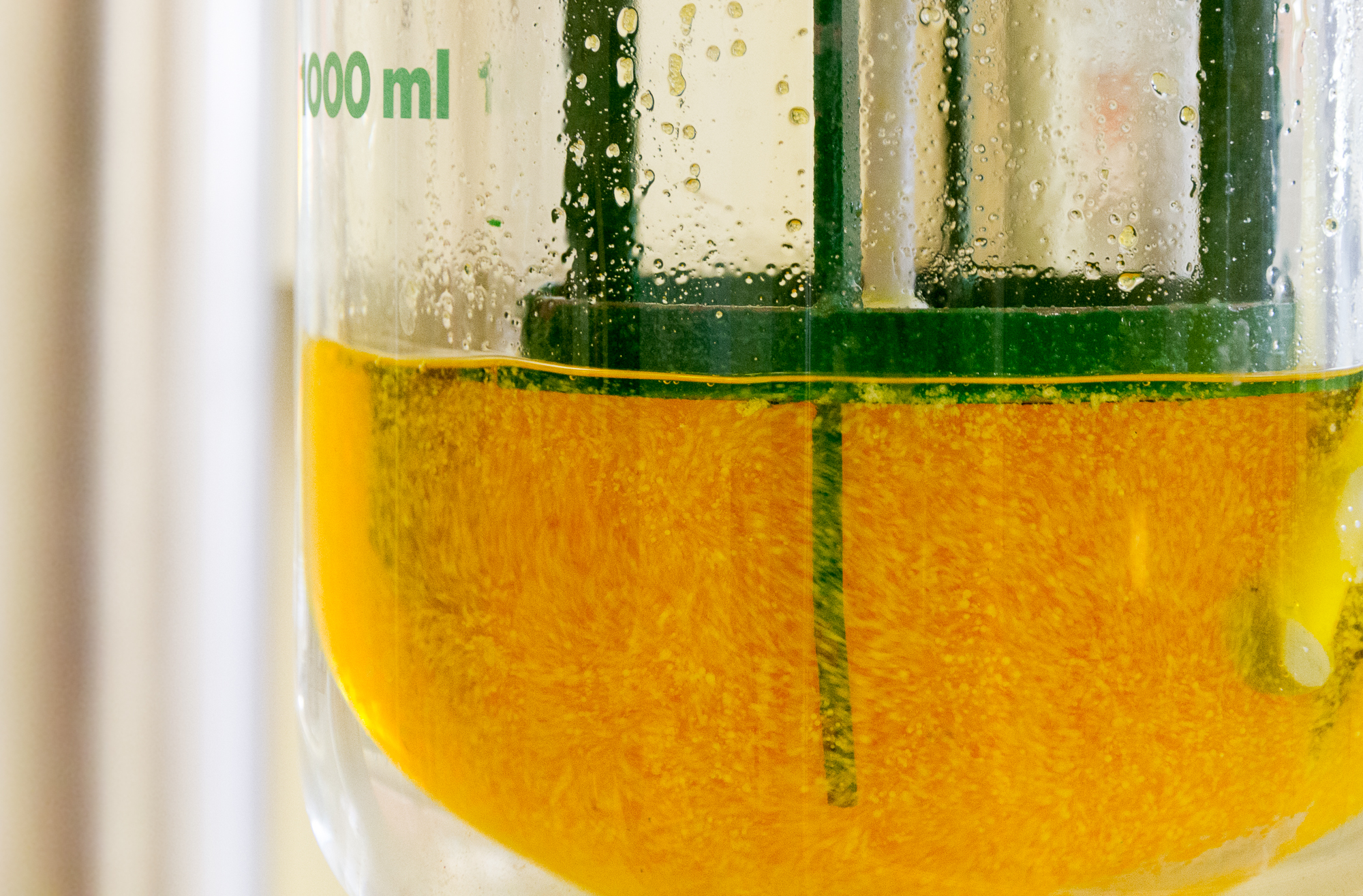
Industrial or white biotechnology provides the methods to produce chemicals and basic chemical substances using biotechnological or combined processes. Due to highly specific catalysts, biotechnological processes represent an alternative when chemical methods are not easily applicable. Microbial processes prove their worth above all when complex metabolic pathways can be used to efficiently convert sugar into fine chemicals. This enables energy- or material-efficient – and thus environmentally compatible and economical – conversion. Examples include the production of highly complex compounds such as vitamins and biosurfactants or amino acids using microorganisms.
Our work aims at the development and optimization of biotechnological (fermentative or biocatalytic) processes for the production of chemicals from renewable resources or biogenic residues. Many microbial processes can also be operated with residual raw materials, such as sugars from lignocellulose pulping processes. In addition to mild reaction conditions and high specificity, biotechnological processes also offer the advantage that the product diversity is virtually inexhaustible due to the large number of different microorganisms.
In order to exploit the full potential of the material diversity of plant biomass, biotechnological processes are combined with suitable chemical processes where necessary. The aim is to design the conversion process in such a way that the resulting compounds are directly available as platform chemicals for the chemical industry and to develop scalable processes that can be closely linked to existing production structures.
Our range of services includes screening for industrially useful enzymes and microorganisms (bacteria, fungi), new chemocatalysts and the development of production processes for fine and basic chemicals including scale-up and product processing. We take into account the scalability of the processes and the purification of the products already during the development of conversion processes on a laboratory scale and the optimization of the biocatalysts themselves.
- Innovation field Industrial Biotechnology
- Innovation field Regenerative Resources – Chemical processes
- Innovation field Sustainable catalytic processes
- Innovation field Bioinspired Chemistry
- Services Biotechnological Processes at Fraunhofer CBP (cbp.fraunhofer.de)
- Equipment Biotechnological Processes at Fraunhofer CBP (cbp.fraunhofer.de)
Reference projects
- KomBiChemPro – fine and platform chemicals from wood by combined chemical-biotechnological processes
- FDCAzymes – Lignocellulose based enzymes for the conversion of 5 hydroxymethylfurfural to 2,5 furanedicarboxylic acid (cbp.fraunhofer.de)
- 2GEnzymes – Enzymes for 2G Sugars (cbp.fraunhofer.de)
- BioQED – Quod Erat Demonstrandum: Large scale demonstration for the bio-based bulk chemicals BDO and IA aiming at cost reduction and improved sustainability
- Lignoplast – Functionalized lignin degradation molecules as platform chemicals (cbp.fraunhofer.de)
Downstream processing
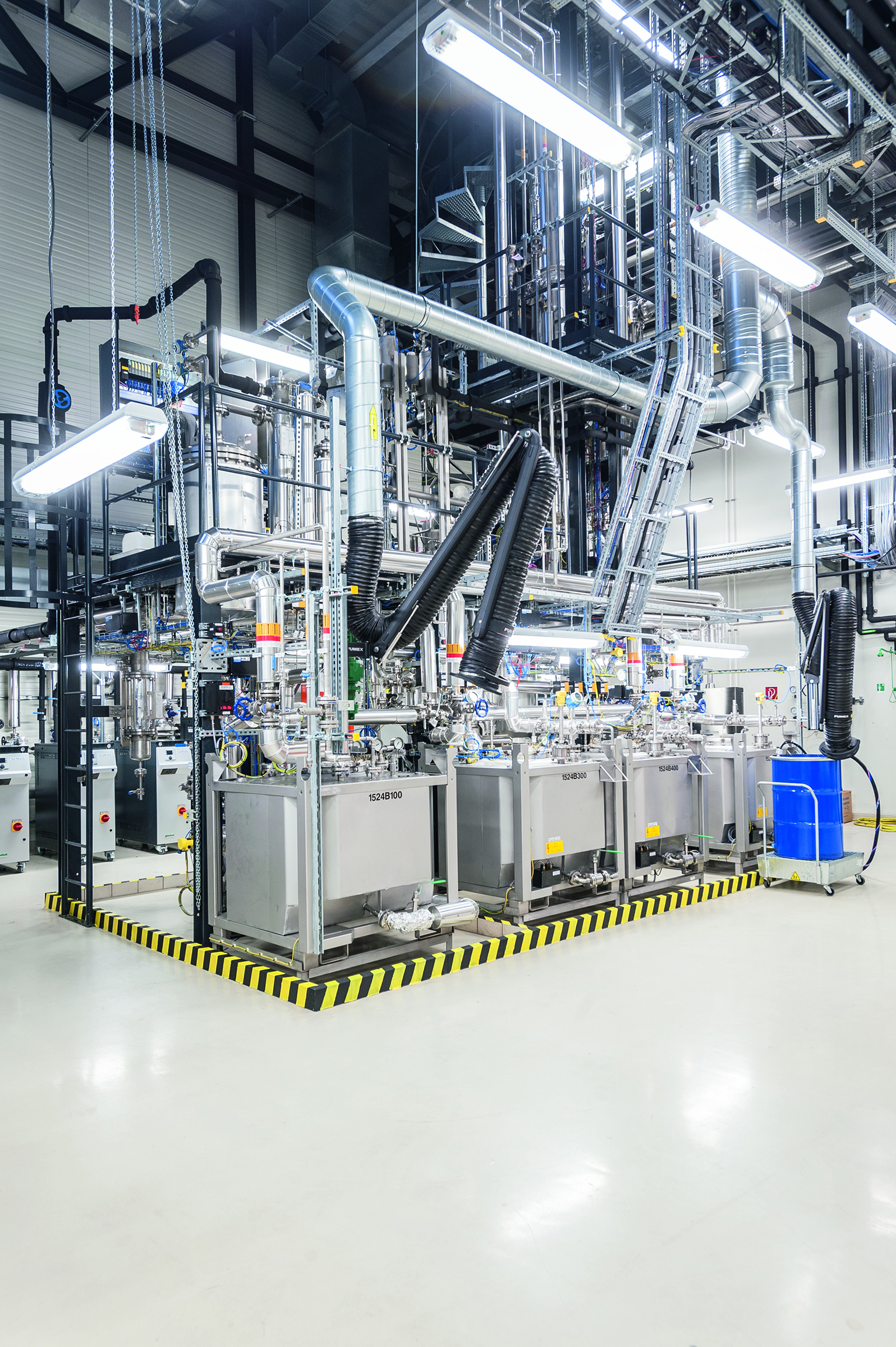
Material separation is a central process step in many areas of the chemical and process industry. Especially in biotechnical processes, the product to be obtained is diluted in the fermentation solution and must be concentrated, isolated and purified from components of the fermentation medium.
For the upstream processing of raw materials as well as for the downstream processing of fermentation and synthesis products, Fraunhofer IGB develops gentle and economical processes, plans appropriate plants and implements the processes for effective product separation and purification.
The focus is on membrane or electrophysical technologies that simplify multistage processing and, if necessary, are combined with conventional separation methods such as centrifugation, extraction or chromatographic methods.
Biobased chemicals and materials
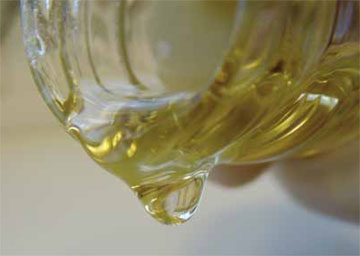
From various raw materials we investigate the production of drop-in and platform chemicals as important intermediates as well as fine chemicals and specialties.
Fermentation and purification processes have been successfully developed at Fraunhofer IGB for C2 compounds (ethylene, acetic acid, ethanol) and C3 compounds (propene, propanol, propanediol, propionic acid, lactic acid), for dicarboxylic acids (malic and itaconic acid, furan dicarboxylic acid), for amino acids or proteins such as thaumatin and bacteriorhodopsin.
Starting from renewable raw materials such as rapeseed oil or algae lipids, production routes for the biotechnological synthesis of basic materials for plastics production, such as long-chain dicarboxylic acids and triglyceride and fatty acid epoxides, were also identified. In the case of long-chain alpha-omega-dicarboxylic acids from oils, the process was optimized in such a way that subsequent purification is as simple as possible.
Other examples of biobased chemicals that have already been investigated at the IGB include aromatics, lignins, phenols and furans as well as extracts and their derivatives (terpenes, phytosterols and camphor) and gaseous and liquid hydrocarbons such as methane, olefins and long-chain alkanes.
We have proven expertise in the microbial production of biosurfactants for use as detergents, emulsifiers and active ingredients in cosmetics, crop protection and technical applications. By optimizing the production process for mannosylerythritol lipids (MEL) and cellobiose lipids (CL) with pyrophytes of the genera Ustilago sp. and Pseudozyma sp. we were able to significantly increase the product concentrations of the biosurfactants discharged into the medium.
Biorefinery concepts
A sustainable approach for the production of chemical products is the most complete possible utilization of biomass according to the principle of a biorefinery. In analogy to the petrochemical refinery, in a biorefinery the raw material is first broken down, separated into different fractions and converted into basic chemicals and intermediate products of varying complexity using chemical or biotechnological, possibly successive process steps. Further conversion steps can be used to create products of higher added value such as fine chemicals or biopolymers. Through coupled production or cascade use, it is possible to combine the material and energetic use of biomass if organic components cannot be used economically for material purposes.
We have already successfully tapped various agricultural and forestry residues (straw, wood waste) as well as organic residues from various branches of industry (whey, crab shells and insect exuviae, terpene-containing residues) as a source of raw materials and, by means of fermentative or biocatalytic and combined chemical processes, we have been able to convert them into basic chemicals which are further processed into fine chemicals or biopolymers. The parallel or subsequent energetic use of the residual biomass closes the cycle and increases the overall efficiency.
Reference projects
Development, integration, scale-up and evaluation of processes
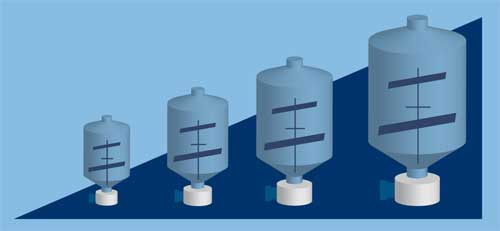
At all stages of the value chain
Our special expertise lies in the fact that we develop and optimize processes along all value-adding process steps – from the preparation of raw materials, through conversion, to the processing of products. As early as the development or optimization of catalysis or fermentation processes, we prepare the developed processes – for example, by means of dimensional analytical considerations – for scale transfer.
Finally, the infrastructure and equipment at Fraunhofer CBP allows us to experimentally verify, validate and optimize scale-up to a scale of 10 m3 fermentation capacity with regard to industrial implementation. We provide sample quantities in kilogram and ton scale for application-technical investigations.
The techno-economic evaluation of the processes plays a decisive role for the implementation in biorefinery concepts. Together with partners, we carry out assessments that serve as a basis for further process and plant design on a demonstration or industrial scale. We accompany life cycle analyses.
 Fraunhofer Institute for Interfacial Engineering and Biotechnology IGB
Fraunhofer Institute for Interfacial Engineering and Biotechnology IGB
